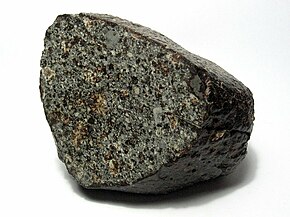L chondrite
| L chondrite | |
|---|---|
| — Group — | |
 NWA 869, an L4-6 chondrite | |
| Type | Chondrite |
| Structural classification | ? |
| Class | Ordinary chondrite |
| Subgroups |
|
| Parent body | Possibly 433 Eros, 8 Flora or the Flora family as a whole |
| Composition | Olivine (characteristic fayalite (Fa) of 21 to 25 mol%), hypersthene (an orthopyroxene), iron–nickel 4–10%, troilite, chromite, Na-rich feldspar, Ca-phosphates |
| Petrologic type | 6 (>60%) |
| Alternative names | L chondrite meteorites, Hypersthene chondrites, Olivine hypersthene chondrites |
 Walters, an L6 chondrite | |
The L type ordinary chondrites are the second most common group of meteorites, accounting for approximately 35% of all those catalogued, and 40% of the ordinary chondrites.[1] The ordinary chondrites are thought to have originated from three parent asteroids, with the fragments making up the H chondrite, L chondrite and LL chondrite groups respectively.[2]
Name[edit]
Their name comes from their relatively low iron abundance, with respect to the H chondrites, which are about 20–25% iron by weight.
Historically, the L chondrites have been named hypersthene chondrites or olivine hypersthene chondrites for the dominant minerals, but these terms are now obsolete.
Chemical composition[edit]
Characteristic is the fayalite content (Fa) in olivine of 21 to 25 mol%. About 4–10% iron–nickel is found as a free metal, making these meteorites magnetic, but not as strongly as the H chondrites.[citation needed]
Mineralogy[edit]
The most abundant minerals are olivine and hypersthene (an orthopyroxene), as well as iron–nickel and troilite. Chromite, sodium-rich feldspar and calcium phosphates occur in minor amounts. Petrologic type 6 dominates, with over 60% of the L chondrites falling into this class. This indicates that the parent body was sizeable enough (greater than 100 kilometres (62 mi) in diameter) to experience strong heating.[3]
Ordovician meteor event[edit]
Many of the L chondrite meteors may have their origin in the Ordovician meteor event, radioisotope dated with uranium-lead method at around 467.50±0.28 million years ago. Compared to other chondrites, a large proportion of the L chondrites have been heavily shocked, which is taken to imply that the parent body was catastrophically disrupted by a large impact. This impact has been dated via cosmic ray exposure at around 468.0±0.3 million years ago.[4][5] Earlier argon dating placed the event at around 470±6 million years ago.[6][7]
Parent body[edit]
The parent body/bodies for this group are not known, but plausible suggestions include 433 Eros and 8 Flora, or the Flora family as a whole. 433 Eros has been found to have a similar spectrum, while several pieces of circumstantial evidence for the Flora family exist: (1) the Flora family is thought to have formed about 1,000 to 500 million years ago; (2) the Flora family lies in a region of the asteroid belt that contributes strongly to the meteorite flux at Earth; (3) the Flora family consists of S-type asteroids, whose composition is similar to that of chondrite meteorites; and (4) the Flora family parent body was over 100 kilometres (62 mi) in diameter.[citation needed]
See also[edit]
References[edit]
- ^ "Natural History Museum, meteorite catalogue". Archived from the original on 2006-05-03. Retrieved 2005-12-18.
- ^ NASA (YouTube) – Dr. David Kring – Asteroid Initiative Workshop Cosmic Explorations Speakers Session
- ^ D. Nesvorný et al. The Flora Family: A Case of the Dynamically Dispersed Collisional Swarm?, Icarus, Vol. 157, p. 155 (2002).
- ^ Lindskog, A.; Costa, M. M.; Rasmussen, C.M.Ø.; Connelly, J. N.; Eriksson, M. E. (2017-01-24). "Refined Ordovician timescale reveals no link between asteroid breakup and biodiversification". Nature Communications. 8: 14066. doi:10.1038/ncomms14066. ISSN 2041-1723. PMC 5286199. PMID 28117834.
A zircon U–Pb date of 467.50±0.28 Ma from a distinct bed within the meteorite-bearing interval of southern Sweden that, combined with published cosmic-ray exposure ages of co-occurring meteoritic material, provides a precise age for the L chondrite breakup at 468.0±0.3 Ma
- ^ Schmitz, Birger; et al. (2019-09-18). "An extraterrestrial trigger for the mid-Ordovician ice age: Dust from the break-up of the L-chondrite parent body". Science Advances. 5 (9): eaax4184. doi:10.1126/sciadv.aax4184. PMC 6750910. PMID 31555741.
- ^ H. Haack et al. Meteorite, asteroidal, and theoretical constraints on the 500-Ma disruption of the L chondrite parent body, Icarus, Vol. 119, p. 182 (1996).
- ^ Korochantseva et al. "L-chondrite asteroid breakup tied to Ordovician meteorite shower by multiple isochron 40Ar-39Ar dating" Meteoritics & Planetary Science 42, 1, pp. 3–150, Jan. 2007.
External links[edit]
- The Catalogue of Meteorites Archived 2006-05-03 at the Wayback Machine


 French
French Deutsch
Deutsch